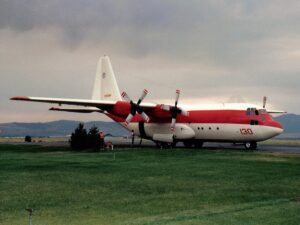
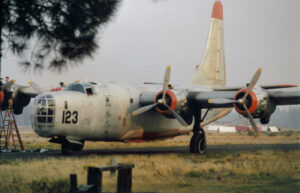 The year 2002 proved to be a really bad one for Hawkins and Powers Aviation of Greybull, Wyoming. Hawkins and Powers had a contract with the United States Forest Service (USFS), to drop fire retardant on wildfires across the country. That year, two large airtankers…a Lockheed C-130 Hercules and a Consolidated PB4Y-2 Privateer…crashed about a month apart while performing aerial firefighting operations. No one saw this coming, but the crashes resulted in a review of the maintenance and use of the entire US large airtanker fleet. Once the review started, they found enough problems that it ultimately brought about the grounding of the whole fleet, which was comprised of 33 aircraft in all. The grounding dramatically reduced the resources available to fight major wildfires. These planes were a vital part of the arsenal used by the forest service to contain wildfires without loss of life and structures. Nevertheless, the planes had to be safe.
The year 2002 proved to be a really bad one for Hawkins and Powers Aviation of Greybull, Wyoming. Hawkins and Powers had a contract with the United States Forest Service (USFS), to drop fire retardant on wildfires across the country. That year, two large airtankers…a Lockheed C-130 Hercules and a Consolidated PB4Y-2 Privateer…crashed about a month apart while performing aerial firefighting operations. No one saw this coming, but the crashes resulted in a review of the maintenance and use of the entire US large airtanker fleet. Once the review started, they found enough problems that it ultimately brought about the grounding of the whole fleet, which was comprised of 33 aircraft in all. The grounding dramatically reduced the resources available to fight major wildfires. These planes were a vital part of the arsenal used by the forest service to contain wildfires without loss of life and structures. Nevertheless, the planes had to be safe.
The review was prompted by the wings of these planes actually folding up and coming off mid-flight, bringing the aircraft down instantly. One of the crashes was actually caught on camera when a tourist was filming the firefighting efforts and happened to be filming at exactly the moment the wings came off. I can only imagine the shock they must have felt when they saw that. I have only seen pictures, knowing full well what is about to happen, and it still gets to me. The thought they were filming an amazing firefighting event, only to find themselves filming a tragedy.
The first accident involved a Lockheed C-130 Hercules, on June 17, 2002, near Walker, California. The plane, registration N130HP, call sign Tanker 130, was flying against the Cannon Fire, which was located south of Lake 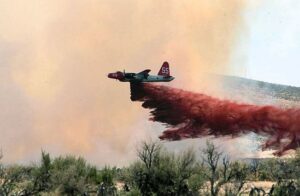 Tahoe and north of Yosemite National Park. The Cannon Fire crossed the California State Line and burned northward into the Walker River area in Nevada. More than 1000 people were evacuated from homes and camps in the mountains near Walker River, and at least one home was destroyed. The fire nearly tripled in size that Monday, growing from 5,000 acres to just under 15,000. The C-130 Hercules that went down fighting the fire killed 3 people that day. The aircraft, “previously United States Air Force (USAF) Serial Number 56-0538, was one of the original C-130A production series and had been built and delivered to the USAF in 1957. It was retired from military service in 1986. In May 1988, the aircraft was acquired from the General Services Administration by the USFS, which in August that year sold it and five other C-130s it had acquired to Hemet Valley Flying Service, for conversion to an airtanker. Hemet then sold the C-130 to Hawkins and Powers. At the time of the crash, the aircraft had logged 21,863 flight hours.”
Tahoe and north of Yosemite National Park. The Cannon Fire crossed the California State Line and burned northward into the Walker River area in Nevada. More than 1000 people were evacuated from homes and camps in the mountains near Walker River, and at least one home was destroyed. The fire nearly tripled in size that Monday, growing from 5,000 acres to just under 15,000. The C-130 Hercules that went down fighting the fire killed 3 people that day. The aircraft, “previously United States Air Force (USAF) Serial Number 56-0538, was one of the original C-130A production series and had been built and delivered to the USAF in 1957. It was retired from military service in 1986. In May 1988, the aircraft was acquired from the General Services Administration by the USFS, which in August that year sold it and five other C-130s it had acquired to Hemet Valley Flying Service, for conversion to an airtanker. Hemet then sold the C-130 to Hawkins and Powers. At the time of the crash, the aircraft had logged 21,863 flight hours.”
The second crash, also caused by structural failure, occurred on July 18, 2002, near Estes Park, Colorado. The structure failure in this case was in the wing’s spar adjacent to the left side of the fuselage. Tanker 123, by callsign, was loaded with 2,000 US gallons of fire retardant at the time of the accident. The plane had begun a left turn to line up for its eighth drop of the day on the Big Elk Fire, and while it was still in the 15–20° left bank, the witnesses on the ground and in another tanker saw the left wing separate from the aircraft and “fold upwards”, followed almost immediately by the initiation of a fire. Without its left wing, the aircraft continued to roll left, and crashed to the ground at a 45° nose down attitude. The impact started a large fire at the wreck site. Both crewmen were killed instantly.
The aircraft, “a Consolidated PB4Y-2 Privateer registered N7620C, was built during World War II. It had been delivered in July 1945 to the United States Navy, which used it for coastal patrol duties. In 1952, it was 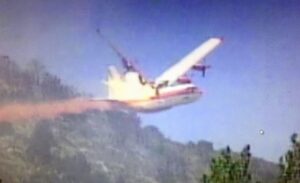
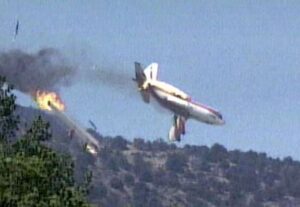 transferred to the United States Coast Guard, which operated it until it was retired in 1956. The aircraft was removed from storage and converted to an airtanker in 1958, then was flown by several different companies, the last being Hawkins and Powers. At the time of the crash, the airframe had logged 8,346.3 flight hours.” The Big Elk Fire burned approximately 4,348 acres.
transferred to the United States Coast Guard, which operated it until it was retired in 1956. The aircraft was removed from storage and converted to an airtanker in 1958, then was flown by several different companies, the last being Hawkins and Powers. At the time of the crash, the airframe had logged 8,346.3 flight hours.” The Big Elk Fire burned approximately 4,348 acres.


Leave a Reply